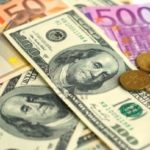 The euro slid to the weakest level in more than a month against the US dollar after European Central Bank President Mario Draghi pledged yesterday central banks policy makers were ready to act should deflationary risks strengthen.
The euro slid to the weakest level in more than a month against the US dollar after European Central Bank President Mario Draghi pledged yesterday central banks policy makers were ready to act should deflationary risks strengthen.
EUR/USD touched a session low at 1.3696 at 06:05 GMT, after which consolidation followed at 1.3700, losing 0.15% for the day. Support was likely to be received at February 28th low, 1.3694, while resistance was to be met at April 3rd, 1.3804.
The European Central Banks policy makers refrained from taking action yesterday and kept the main refinancing rate at a record-low 0.25%, after which the President of the central bank Mario Draghi commented that officials “do not exclude further monetary policy easing.” Draghi said that the Governing Council of the ECB had discussed possible measures to fight against deflation and all the members were “unanimous” that the central bank should explore new policy avenues.
Draghi gave his strongest signal so far that the ECB is ready and may use a policy that is mainly associated with large-scale government bond purchases, known as Quantitative easing (QE). However, the central bank may have to design its own approach to QE, different from the one implemented by the US Federal Reserve, because of the specificity of the euro areas economy.
“Given ECB President Draghi’s more dovish remarks it appears that the probability of additional monetary policy action has been rising,” Manuel Oliveri, a foreign-exchange strategist at Credit Agricole Corporate & Investment Bank, wrote in an e-mailed note to clients today, cited by Bloomberg. “We remain of the view that being long the EUR from the current levels offers little risk reward.”
The ECB President is struggling to convince investors that the central bank is ready to do whatever it takes to prevent a Japan-style deflationary spiral. At the same time, there are a number of political and economic obstacles to a wide wave of sovereign-asset purchases, which probably makes a program aimed at increasing bank lending more appropriate. Boosting bank lending is a way to improve credit conditions form small-and-medium sized entities, which are the backbone of the euro region economy.
Meanwhile, dollars demand was heightened amid expectations a government report scheduled to be released later today may show private payrolls rose by 200 000 in March, the most in four months, according to the median experts’ forecast. Data may also show that the jobless rate stood at 6.6% last month, matching January’s reading and the weakest since October 2008. If confirmed, these data points will add to signs the US labor market is strengthening, which will back the case for further stimulus reductions.
However, the US trade deficit widened by 7.7% to $42.3 billion, the largest since September from $39.3 billion in the previous month, data by the US Commerce Department showed yesterday. Analysts had predicted that the trade deficit will narrow to $38.5 billion. The increasing gap was led by declines in exports of fuels and capital goods, while imports remained steady.





